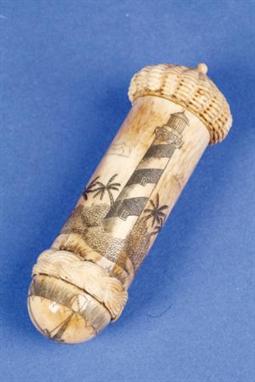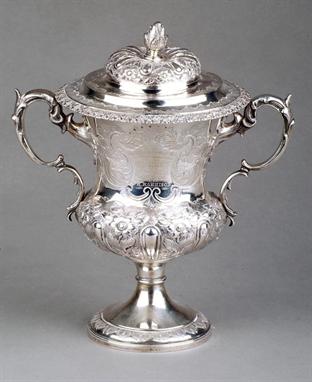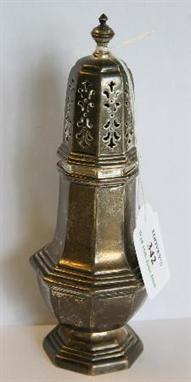We found 116003 price guide item(s) matching your search
There are 116003 lots that match your search criteria. Subscribe now to get instant access to the full price guide service.
Click here to subscribe- List
- Grid
-
116003 item(s)/page
A VICTORIAN TEAPOT of baluster form, the hinged domed lid with perched eagle finial and leaf-capped scroll handle, the spout cast in the form of a rocaille mask with eagles head terminal, the body embossed with flowers and scrolls, with vacant cartouches, the whole on a pierced foot, by Martin Hall & Co., Sheffield 1853, (c.26oz) 8” high.
A CONTINENTAL MOTHER OF PEARL AND GILT METAL PERFUME BOTTLE HOLDER, the base pierced with grape and vine, and four “cabochon” mother of pearl shells, surmounted by two opening shells enclosing four faceted glass perfume bottles, in pierced gilt metal mounts surmounted by a shell finial, 12”.
AN IMPORTANT PAIR OF ENGLISH BRASS FOUR-BRANCH CHANDELIERS, each with a baluster shaft incorporating a flattened globular central section from which emanate four scrolling branches, with plain nozzles, circular drip pans and a stylised acorn finial to the shaft, probably circa 1760, 22¼” dia. (2).. Provenance: Acquired from Rupert Gentle in the 1960’s, or 1970’s. Private Collection, Dorset. Rupert Gentle and Rachel Field illustrate a small chandelier in “English Domestic Brass 1680-1810” (published London 1975), plate 121. The illustrated chandelier is almost certainly one of the pair offered here. According to Gentle and Field, the normal “S”-scroll of the four branches has been “kinked” to a rather more elaborate shape. They propose a date of circa 1760-65.
A GEORGE III MAHOGANY LONGCASE CLOCK, with brass dial and silvered chapter ring, with a strike/silent dial above, signed William Gass, London, the dial with subsidiary seconds dial and date aperture, with an eight-day movement striking on a bell, the arch topped hood surmounted by a ball and pinnacle finial, the trunk with an arch topped door, 89” high.
A REGENCY MAHOGANY AND BRASS INLAID BRACKET CLOCK by “Ellicott, The Royal Exchange, London” with a convex white enamel dial with Roman numerals, with an eight day twin fusee movement striking on a bell and with repeat mechanism, with engraved back plate and pendulum, the case with a pineapple finial to the top, the front with scrolling foliate brass inlay, the sides with twin gilt metal carrying handles and pierced “fish scale” panels, on short ball feet, 20” high.. See illustration
AN OAK “YEOMANS” BED with raised headboard with a central turned finial above arch topped panels and square section uprights with conforming finials, with panelled side rails and footboard, basically 17th century, 51” wide.. Provenance: Purchased in 1952 at the Eleven Day Sale of the Contents of Coldbrook Park, Abergavenny by direction of the Trustees of the Late Lady Helen Herbert. The Park first appears as the seat of Sir Richard Herbert in the reign of Henry VI. Colonel Henry Herbert of Coldbrook was rewarded by Cromwell with the contents of Raglan Castle. It is conceivable that this bed was part of those contents. The bed was gifted to the vendor in 1986.
A George III mahogany long case clock with reeded finial and carved rose paterae to the swan neck pediment, brass capped Corinthian columns to the hood, cluster columns and triple arched figured door to the trunk, inlaid canted corners to the base, on ogee bracket feet, square brass dial with silvered chapter ring and centre dial, by W Barnish Rochdale (case a.f.) height 94"
A Hornby Series No.2 Signal Gantry circa 1930 with blue bases and ladder, blue finials and bridge with white rails and upright with `Home` and `Red` distance signals, a 2E Double Arm signal circa 1936 with lighter blue base and ladder, light blue finial, red levers and `home` and `yellow` distance arms
A Group of four Hornby Series Accessories, a No.2 Foot Bridge with signals circa 1930 in white with blue lining and blue bases, the signals with black levers, black finials and white posts on black bases, a Hornby Lamp Standard No.2E with green base and lamps and red finial, a No.2 double arm signal circa 1936 with green base and ladder and a No.2 signal circa 1924 with black base and ladder and black lever
The Speaking Picture Book, Imitating the Cries of Animals. An Amusement for the Little Ones” Eyes and Ears, n.p., c.1890, eight full-page chromo. illusts., with related poems, occn. light finger-soiling and spotting, one or two short edge-tears, each page with corresponding “pull” to activate a sound effect (all working), each pull with turned ivory finial (one lacking), final thick card leaf detached from bookform box revealing mechanism, orig. pictorial cloth, lightly rubbed and dust-soiled, lower cover damp-stained, corners showing, oblong 4to. The sounds produced are that of the cock, the donkey, the goat, ducks, the cat, sheep, the cow and the horse. Unusually with all the voices working. Haining calls this “the pi?ce de rŽsistance of any collection of moveables” and adds that very few complete and fine copies have ‘survived youthful hands.” (Haining, Moveable Books, pp.136/7) (1)
A Greenwich Centennial Maritime mantel clock, the ship finial above gilt and silver plated terrestrial globe with brass meridian and equator rings, silvered chapter rings with Roman numerals raised on a cylindrical double barrel movement supported by three gilt mermaid figures, stamped ‘St James House Co. London No. 151 of 1500’ the whole supported on an oak socle on scroll feet, 38cm high.
A matched George III Irish silver oblong baluster three piece tea service, maker’s marks ‘W.D’ (not traced) and perhaps ‘I.S’ (worn), Dublin 1813 and 1815 (sugar basin), with egg-and-dart shaped rims, engraved bands and on ball feet, the tea pot with an ebonised harp handle, the tea pot 32cm (12.5in) long, 1128g (36.6 oz) gross (the finial a replacement)
A matched silver oblong baluster three piece tea service by Elkington & Co., Birmingham 1909, 1907 and 1911, stamped for Elkington & Co. as retailer, with a nulled rim, half gadrooning and the tea pot with a composition finial and harp handle, the tea pot 28.5cm (11.25in) long, 1140g (36.65 oz) gross
An Edwardian silver pierced ‘lighthouse’ sugar caster by Haseler Bros, London 1904, with a twist spire finial, a bayonet fixing and scroll piercing, 19.5cm (7.75in) high, with a blue glass liner; and a Victorian ogee baluster pedestal sugar caster by Thomas Bradbury & Sons, Sheffield 1882, with a twist spire finial, a dot pierced domed cover and a circular foot, 430g (13.85 oz) gross weighable
[Horse racing interest] A Victorian silver twin handled pedestal trophy cup and cover by Walker & Hall (John Edward Bingham) , Sheffield 1888, incused stamped by Walker & Hall (‘W&H’ on a flag), the finial modelled as a horse with jockey up, a domed moulded cover, moulded high loop handles, embossed with foliage and scroll-work, the front reserve presentation engraved ‘The Paddy Butler Memorial Cup’, the reverse with a jumping scene, on a tapered stem and a circular foot, 45cm (17.5in) high, 1660g (53.35 oz); with an ebonised socle (the base of the stem almost split through at the foot)
A Victorian silver mounted cut and etched glass claret jug by George John Richards & Edward Charles Brown, London 1862, with a grapes and leaf finial to the leaf embossed cover, an S-scroll stock handle with grapes in relief, the mount and girdles as fruiting vine, on a globe and spire body with vine decoration, 29cm (11.5in) high
A George IV silver twin handled cup and cover, possibly by William Bateman (mark rubbed), London 1828, with a bud finial, double C-scroll handles, embossed with flowers and lobes on a matted ground, on a circular foot, the interior gilt, later presentation engraved for the First Lincolnshire Rifle Volunteers, 1861, 26cm (10.25in) high, 842g (27 oz)
-
116003 item(s)/page






































![[Horse racing interest] A Victorian silver twin handled pedestal trophy cup and cover by Walker & Hall (John Edward Bingh](http://lot-images.atgmedia.com/SR/10011/2795086/62-2010525135227_468x382.jpg)
















